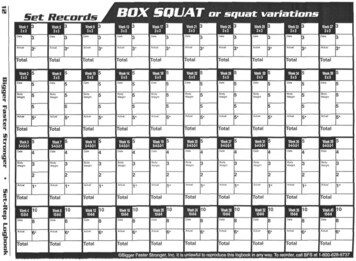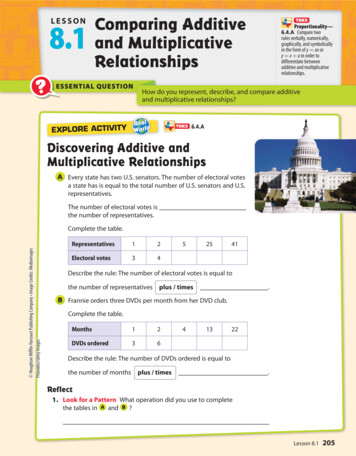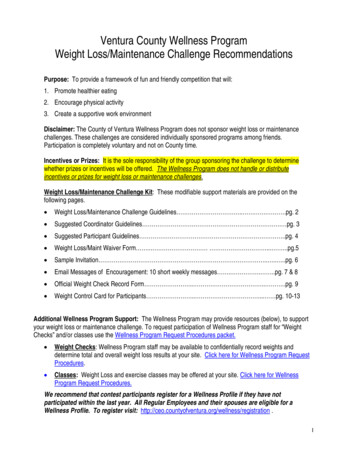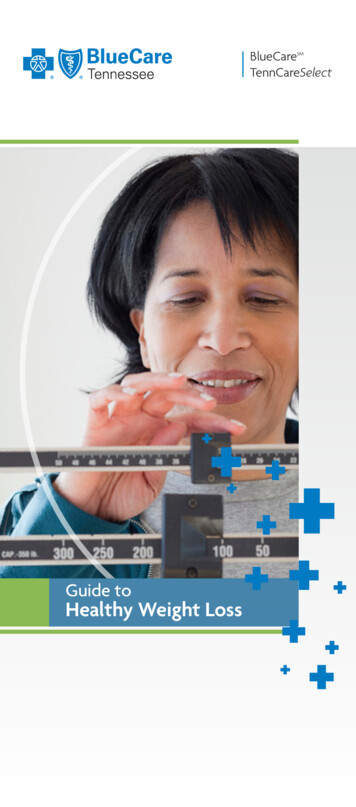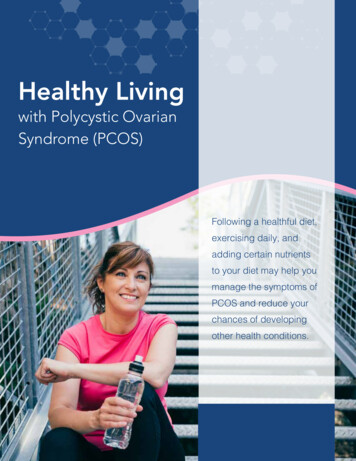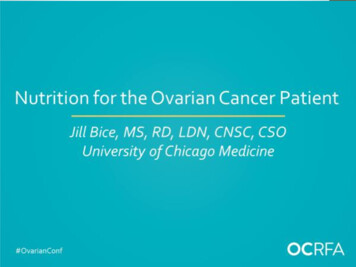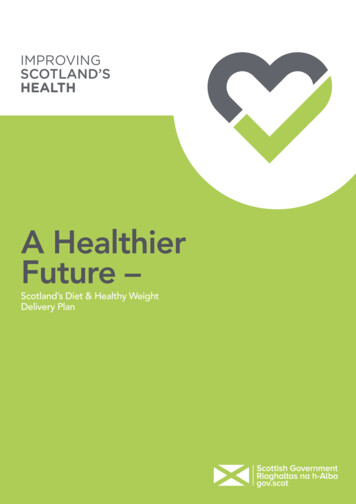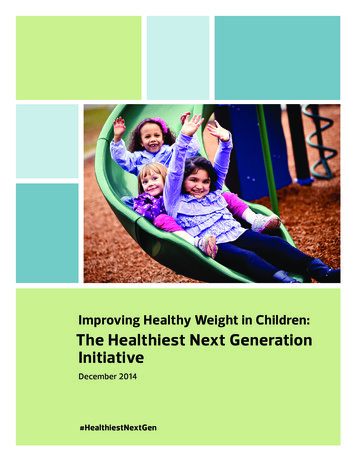
Transcription
Improving Healthy Weight in Children:The Healthiest Next GenerationInitiativeDecember 2014#HealthiestNextGen
Improving Healthy Weight in Children:The Healthiest Next GenerationInitiativeDecember 2014For more information or additional copies of this report contact:Washington State Department of HealthDivision of Prevention and Community HealthOffice of the Assistant SecretaryPhone: 360-236-3766John Wiesman, DrPH, MPHSecretary of HealthCover Photo: Courtesy of YMCA of Pierce and Kitsap Counties, 2013
This should be unacceptable to us.We need to make the next generation thehealthiest generation in the history of our state.‘‘‘‘Research shows that, for the first time in ourhistory, this generation is not expected to liveas long as the previous generation.1—Governor Jay Inslee2014 State of the State Address1Pam Belluck, “Children’s Life Expectancy Being Cut Short by Obesity,” TheNew York Times, March 17, 2005, tml? r 2& accessed on October 30, 2014.
AcknowledgementsThe Department of Health is grateful for the resources and support to assist in one of ourtop priorities — improving healthy weight in children. We especially wish to thank GovernorJay Inslee, First Lady Trudi Inslee, Governor’s Office, Department of Early Learning,Office of Superintendent of Public Instruction, Governor’s Interagency Council on HealthDisparities, members of the Community Steering Committee, members of the Governor’sCouncil for the Healthiest Next Generation and other partners for their dedication toimproving children’s health.We are also very appreciative of the hundreds of individuals and community organizationswho shared their success stories with us. We consider those stories the heart of theHealthiest Next Generation Initiative and we hope you see yourselves in this work.Governor’s Council for the Healthiest Next GenerationHonorable Randi Becker, State Senator, Washington State LegislatureMarc Berejka, Director, Government and Community Affairs, REIBrian Bonlender, Director, Department of CommerceAntony Chiang, President, Empire Health FoundationDebra Clemens, Superintendent, Cheney School DistrictHonorable Annette Cleveland, State Senator, Washington State LegislatureHonorable Eileen Cody, State Representative, Washington State LegislatureGary Cohn, Superintendent, Everett Public SchoolsVic Colman, Director, Childhood Obesity Prevention CoalitionNora Coronado, Commissioner; Coordinator, Commission on Hispanic Affairs;University of Washington Latino Center for HealthEmma Medicine White Crow, Chair, Governor’s Interagency Council on Health DisparitiesBen Danielson, Clinical Director, Odessa Brown Children’s ClinicBret D. Daugherty, Adjutant General, Washington Military DepartmentRandy Dorn, State Superintendent, Office of Superintendent of Public InstructionLori Dunn, Manager, PreK-12 Physical Education, Seattle Public SchoolsHugh Ewart, Director, State and Federal Government Relations, Seattle Children’sHonorable Jessyn Farrell, State Representative, Washington State LegislatureScott Forslund, Director, Snohomish County Health Leadership Coalition andProvidence Institute for a Healthier CommunityDebra French, Executive Director, Washington State Dairy CouncilHoward Frumkin, Dean, School of Public Health, University of WashingtonMelanie Gillespie, Executive Director, Foundation for Healthy GenerationsHeather Gillette, Board President, Washington State PTADanette Glassy, Pediatrician, Washington Chapter, American Academy of PediatricsKathryn Grandy, Marketing Coordinator, Chelan Fresh Marketing
Honorable Paul Harris, State Representative, Washington State LegislatureCarrie Hite, President; Director, Washington Recreation and Parks Association;Edmonds Parks, Recreation, and Cultural ServicesKathryn Hobbs, Executive Director, Washington State PTAKatie Holmes, Senior Vice President, Operations and Membership, Washington State Hospital Assn.Bette Hyde, Director, Department of Early LearningHonorable Jay Inslee, Governor of WashingtonFirst Lady Trudi InsleePaul Johns, Director, Youth Football and Alumni Programs, Seattle SeahawksEric Johnson, Executive Director, Washington Association of CountiesMona Johnson, Director, Student Support, Office of Superintendent of Public InstructionHonorable Karen Keiser, State Senator, Washington State LegislatureStephen Kutz, Chair, American Indian Health CommissionSteve Leahy, Director, Mission Readiness, Washington StateLaurie Lippold, Public Policy Director, Partners for Our ChildrenRobert Matthews, General Manager, Integrated Marketing Devices and Studios, MicrosoftSheri Nelson, Director, Government Affairs, Association of Washington BusinessSara Osborne, Director, Public and Government Affairs, Safeway Inc., NW DivisionLynn Ann Peterson, Secretary, Department of TransportationKevin Quigley, Secretary, Department of Social and Health ServicesHonorable Marcus Riccelli, State Representative, Washington State LegislatureMac Riggan, Vice President of Marketing, Chelan Fresh MarketingKirk Robinson, Assistant Director, Department of AgricultureDavid Schumacher, Director, Office of Financial ManagementTom Seigel, Superintendent, Bethel School DistrictAnne Stone, Executive Director, Washington Chapter, American Academy of PediatricsDorothy Teeter, Director, Health Care AuthorityKaitlin Todd, President, Washington Academy of Nutrition and DieteticsMatt Watrous, Executive Director, Boys and Girls Club of Washington StateMike West, President and CEO, South Sound YMCASam Whiting, President and CEO, Thrive by FiveJohn Wiesman, Secretary, Department of HealthCommunity Steering CommitteeDonna Allis, Health Services Administrator, Public Health–Seattle & King CountySue Anderson, Executive Director, Statewide Pioneering Healthier Communities,Washington State Alliance of YMCAsJanna Bardi, Director, Office of Healthy Communities, Department of HealthJoan Brewster, Director, Grays Harbor County Public Health and Social Services DepartmentPreston Cody, Health Care Services Division Director, Health Care AuthorityBill Cole, Managing Director, Community Capital Facilities, Department of Commerce
Vic Colman, Director, Childhood Obesity Prevention CoalitionIan Corbridge, Policy Director, Clinical Issues, Washington State Hospital AssociationKathleen Davis, Director, Local Programs, Department of TransportationRegina Delahunt, Director, Whatcom County Health DepartmentElaine Engle, Director, Health Education and Promotion (retired), Spokane Regional Health DistrictDanette Glassy, Pediatrician, Washington Chapter, American Academy of PediatricsGary Goldbaum, Director, Snohomish Health DistrictLindsay Hovind, Government Relations Director, American Heart Association, WashingtonNat Jackson, Premier Wellness Coach, Wellness FirstDanielle Kenneweg, Manager, Health Promotion & Communication Section,Office of the Assistant Secretary, Department of HealthJefferson Ketchel, Administrator, Grant County Health DistrictMary Looker, Chief Executive Officer, Washington Association of Community andMigrant Health CentersSarah Lyman, Senior Associate, Strategy and Operations, Empire Health FoundationJason McGill, Health Policy Advisor, Governor’s OfficeAlan Melnick, Director/Health Officer, Clark County Public HealthJan Ward Olmstead, Coordinator, Public Health Projects, American Indian Health CommissionMadeline Otto, Director of Federal Government Relations, Group HealthJulie Peterson, Senior Director of Policy, Foundation for Healthy GenerationsKirk Robinson, Assistant Director, Department of AgricultureMona Johnson, Director, Student Support, Office of Superintendent of Public InstructionKyle Unland, Director, Health Promotion Division, Spokane Regional Health DistrictGreg Williamson, Assistant Director, Partnerships and Collaboration, Department of Early LearningBrady Woodbury, Administrator, Asotin County Health DistrictEquity Review Group:Governor’s Interagency Council on Health DisparitiesSofia Aragon, Chair, Commission on Asian Pacific American AffairsGail Brandt, Health Equity Manager, Department of HealthKameka Brown, Member, Commission on African American AffairsNora Coronado, Member, Commission on Hispanic AffairsEmma Medicine White Crow, Chair, Governor’s Interagency Council on Health DisparitiesJames Krieger, Chief, Chronic Disease & Injury Prevention, Public Health–Seattle & King CountyStephen Kutz, Chair, American Indian Health CommissionDevon Love, Project Director, Center for MultiCultural HealthFrankie Manning, Vice Chair, Governor’s Interagency Council on Health DisparitiesJason A. Mendoza, Associate Professor of Pediatrics, University of Washington;Investigator, Seattle Children’s Research InstituteSusan Millender, Executive Director, Guided Pathways–Support for Youth and FamiliesMartin Sanchez, Community Health Coordinator, Yakima Valley Memorial Hospital
Celeste Schoenthaler, Healthy Eating & Active Living Program Manager, Public Health–Seattle & King CountyGwendolyn Shepard, Member, Governor’s Interagency Council on Health DisparitiesTyati Tufono, 1st Vice Chair, Commission on Asian Pacific American AffairsStaffAmy Blondin, Government and Community Relations Manager, Department of Early LearningDrew Bouton, Director of Policy, Legislative and Constituent Relations, Department of HealthGail Brandt, Health Equity Manager, Department of HealthAdrienne Dorf, Healthiest Next Generation Program Manager, Department of Early LearningAmy Ellings, Healthy Eating Active Living Program Manager, Department of HealthChristy Curwick Hoff, Health Policy Advisor, State Board of HealthBridget Igoe, Nutrition Coordinator, Department of HealthMona Johnson, Director, Student Support, Office of Superintendent of Public InstructionAllene Mares, Assistant Secretary, Prevention and Community Health, Department of HealthJason McGill, Health Policy Advisor, Governor’s OfficeDaisye Orr, Organizational Performance, Development, and Results Manager, Department of HealthLisa Rakoz, Healthiest Next Generation Program Supervisor,Office of Superintendent of Public InstructionTracy Wilking, Healthiest Next Generation Coordinator, Department of HealthGreg Williamson, Assistant Director, Partnerships and Collaboration, Department of Early LearningDennis Worsham, Deputy Secretary for Public Health Operations, Department of Health
Table of ContentsA Call to Action . . . . . . . . . . . . . . . 1Update on Proviso Activities . . . . . . . . . . . 4The Opportunity . . . . . . . . . . . . . . . 5The Challenge . . . . . . . . . . . . . . . 10Detailed Update on Proviso Activities . . . . . . . . . 12How to Create the Healthiest Next Generation . . . . . . 17Recommendations from the Governor’s Council . . . . . 17Recommendations Crosswalk: Institute of Medicinewith the Healthiest Next Generation . . . . . . . . 20Washington in the Context of National Guidance . . . . . . 23Early Learning Settings . . . . . . . . . . . . 23Schools . . . . . . . . . . . . . . . . 26Reducing Child-related Health Disparities . . . . . . . . 29Tobacco, E-cigarette, Vapor Product and Marijuana Prevention . . 3 1Opportunities for Sustaining Our Success . . . . . . . 34Appendices . . . . . . . . . . . . . . . . 36Appendix A: Governor Policy Brief . . . . . . . . . . 37Appendix B: Engrossed Substitute Senate Bill 6002(Section 219) . . . . . . . . . . . . . . . . 40Appendix C: Reviewed National Guidance . . . . . . . 41Appendix D: Recent Legislative Activity in Other States 2012–2013 . 42
This page is left blank intentionally.
A Call to ActionIf we want the next generation to be the healthiest ever, we musttake vigorous action now. The Healthiest Next Generation Initiativeis an opportunity to act on what we know works — to support familiesin helping their children grow up healthy and create systems inWashington that serve all children equally.Unhealthy weight among our children is a contemporary problemlinked to societal changes that we have the opportunity to correct.For example: In 1969, about 48 percent of students in the United States walkedto school. This number dropped to 13 percent in 2009.2A five percentdrop in bodymass index inWashington Statecould potentiallysave 5 billion inhealthcare costsin 10 years and 14billion in 20 years.2 In 2012, about 72 percent of 10th graders in Washington did notparticipate in daily physical education classes.3The goal of the Healthiest Next Generation Initiative is to helpWashington’s children maintain a healthy weight, enjoy active livesand eat well by creating healthy early learning settings, schools andcommunities. It is the product of partners in communities acrossWashington, with the support and leadership of Governor Jay Insleeand First Lady Trudi Inslee and the Washington State Legislature, theDepartments of Health and Early Learning and Office of Superintendentof Public Instruction. These groups have come together to work onthis important issue collaboratively. The Healthiest Next GenerationInitiative is inspired by communities that have already madeimprovements to support their children. Now is our opportunityto make those improvements statewide.Creating the healthiest next generation is within our reach if we: Sustain the Healthiest Next Generation Initiative by continuingfunding of the program staff at the Departments of Health andEarly Learning and Office of Superintendent of Public Instruction. Ensure resources are available for a comprehensive youth tobaccoand marijuana prevention campaign, that includes E-cigarettes andvapor products.2“Bending the Obesity Cost Curve in Washington,” Trust for America’s Health and Robert WoodJohnson Foundation, Washington, D.C., September 2012, /rwjf401512 accessed on February 11, 2015.3Healthy Youth Survey: Physical Activity for Washington State, 2012.The Healthiest Next Generation Initiative – December 2014 1
Implement the policy recommendations identified and prioritizedby the Governor’s Council for the Healthiest Next Generation forimmediate and short-term action.The Governor’s Council for theHealthiest Next GenerationOn September 18, 2014, Gov. Inslee convened the first meeting of theGovernor’s Council for the Healthiest Next Generation. This group ofbusiness and community leaders, representatives of the healthcarecommunity, legislators, state agencies and local government discussedtheir top priorities for improving healthy weight in children andprioritized a set of recommendations; those featured in bold wereidentified as top priorities.Recommendations for short-term action, within the next three years,to create the Healthiest Next Generation:EARLY LEARNING SETTINGS Increase training on nutrition, physical activity and screen time inEarly Achievers. Update the rules and regulations for licensed Child Care Centers toaddress the latest version of national standards on nutrition, physicalactivity and screen time and include required training for providers(initial, ongoing and professional development) on these topics. Fund regional Early Learning Collaboratives to help increase thecapacity of licensed Child Care Centers to meet updated rules andregulations.SCHOOLS Encourage school districts to adopt a health and fitness educationcurriculum aligned with updated state standards. Feed all children well by increasing voluntary participation inbreakfast programs such as Breakfast After the Bell, eliminatingthe co-pay for school lunch in grades 4-12 and supporting theSummer Food Service Program. Breakfast After the Bell is anyschool breakfast program that provides students an opportunityto eat breakfast after the start of the instructional day.2 The Healthiest Next Generation Initiative – December 2014
Encourage schools to provide active daily recess. Encourage drinking water by such actions as installing water bottlefilling stations in schools. Add 30 minutes dedicated physical activity time [in schools]. Adopt a late start for high schools.COMMUNITIES Implement healthy communities programs statewide. Localcollaboratives throughout the state work together to improve healthoutcomes through community-wide strategies increasing access tohealthy food, physical activity opportunities and tobacco-free living. Implement Safe Routes to School programs statewide and requirea consistent Walking School Bus for all schools receiving funds.Safe Routes to School programs work to improve safety andaccessibility and reduce traffic and air pollution near schools. As aresult, these programs help make bicycling and walking to schoolsafer and more appealing transportation choices thus encouraginga healthy and active lifestyle from an early age. A Walking SchoolBus is a group of children walking to school with one or more adults. Encourage breastfeeding by implementing Breastfeeding FriendlyWashington, funding Medicaid to reimburse for breastfeedingeducation and lactation counseling and assuring breastfeedingsupport is defined and covered by insurance. Implement complete streets statewide. Complete streets are forpedestrians, bicyclists, motorists and transit riders. They allow peopleof all ages and abilities the opportunity to move safely along a street.A complete street may include sidewalks, bike lanes, bus shelters,pedestrian signals, median islands and more. Encourage fruit and vegetable purchases through Washington’s BasicFood (food stamp) program.The Healthiest Next Generation Initiative – December 2014 3
Update on Proviso ActivitiesOverview: July to October 2014See Appendix B for the text from Engrossed Substitute Senate Bill 6002,Section 219. A detailed update on proviso activities follows on page 12.ItemStatusCurrent ImpactExpected ImpactExpansion of programsacross Washington that havedemonstrated success inincreasing physical activity,access to healthy food anddrinking water.IdentificationcompleteList ofevidence-basedrecommendationsvetted by partnersand stakeholders.Statewide implementationof recommendations thatcan improve health of allchildren.Provide toolkits andmentoring for early learningand school professionals toencourage children to beactive, eat healthy food andhave access to drinking water.In progress –complete byJuly 1, 2015Identificationof resourcesand interestedindividuals.Resources and mentoringwill be available to thestaff in 295 school districtsand to over 6,000 childcare programs.Enhance performancestandards for the EarlyChildhood Education andAssistance Program (ECEAP).BeginningJanuary 2015Hiring of licensedhealth professionalin Department ofEarly Learning tolead this work.Increase the healthy eatingand physical activity ofover 8,300 children.Revise statewide guidelinesfor quality health and fitnesseducation in schools.In progress –complete byJuly 1, 2015State’s health andfitness guidelinesare in line withnational standards.Potential increase in thehealth of over 1 millionstudents annually.Establish performancemetrics.In progress –complete byJuly 1, 2015Alignment withResults Washington.Ability to measureprogress toward goal ofcreating healthiest nextgeneration.4 The Healthiest Next Generation Initiative – December 2014
The OpportunityThe Healthiest Next Generation Initiative is an opportunity forcommunity organizations, businesses, state and local agencies andother partners to collaborate under a common vision and goal.Achieving this goal will present many related opportunities: Serving children more fruits and vegetables in early learning settingsand schools can also support local agricultural business. Supporting children walking and biking to school can result inimprovements to school grounds, sidewalks and streets andpotentially decrease school transportation costs and traffic impacts. Healthy children overall perform better in school. A study publishedby researchers in 20084, using data from the National LongitudinalSurvey of Youth 1997 cohort and after accounting for familycharacteristics, showed “adolescents with poorer general healthwere found to be less likely than healthier students to graduate fromhigh school on time and attend college or post-secondary education.”5 In the school environment, children’s health is impacted by theiraccess to physical activity and nutrition. Similarly, interventionsrelating to increased physical activity for children during theschool day, through either extended physical activity or classroomphysical activity breaks, have shown that, “students perform betteror the same as control groups, despite their having less classroominstruction time.” 6 A study conducted with elementary and middleschool students in Baltimore and Philadelphia in which participatingstudents received a free breakfast found that those students hadimproved nutrition, reduced depression and anxiety, improvedattendance and higher math grades.74Steven A. Hass and Nathan Edward Fosse, “Health and Educational Attainment of Adolescents:Evidence from the NLSY97,” Journal of Health and Social Behavior, Vol. 49, No. 2, June 2008,pp. 178-192.5Julia Dilley, “Research Review: School-based Health Interventions and Academic Achievement,“Washington State Board of Health, Washington State Office of Superintendent of PublicInstruction, Washington State Department of Health, September 2009, p. 2.6Ibid, p. 16.7Ibid, p. 17.VISION:Make our nextgeneration thehealthiest ever.GOAL:Help our childrenmaintain a healthyweight, enjoy activelives and eat wellby creating healthyearly learningsettings, schoolsand communities.The Healthiest Next Generation Initiative – December 2014 5
Focus Areas of theHealthiest Next Generation InitiativeThe focus areas of the Healthiest Next Generation Initiative are notnecessarily new. In fact, the heart of the Healthiest Next GenerationInitiative is to elevate changes that are already under way in someearly learning settings, schools and communities to reach acrossWashington — to promote breastfeeding and help children eat welland enjoy active lives. Yet these changes are occurring only in pockets,often as a result of a grant or a local champion, and disparities persist.Focus AreasHealthy Early Learning SettingsInfants and children cared for inearly learning environments are: Breastfed or fed breastmilksafely pumped and stored bytheir mother Active every day Playing in safe places Spending less time in frontof screens Eating nutritious snacks andmeals Drinking clean water insteadof sugar-sweetened drinksHealthy SchoolsChildren in school are: Active every day Playing in safe places Eating nutritious meals Drinking clean water insteadof sugar-sweetened drinksHealthy CommunitiesChildren grow up incommunities where: It is easy to find affordable,healthy food There are safe places toplay and be active Hospitals follow theTen Steps to SuccessfulBreastfeeding Employers provide a safeplace to pump and storebreastmilk Healthcare providersencourage breastfeedingWhat is new about the Healthiest Next Generation Initiative is thepotential for state resources to make statewide changes that impact allcommunities in Washington, and the collaborative leadership of threestate agencies and the Governor’s Office to improve healthy weight inWashington’s children. One-time funding from Engrossed SubstituteSenate Bill 6002 in July 2014 (hereafter referred to as the proviso,included in Appendix B) established a formal collaboration between theDepartments of Health and Early Learning and Office of Superintendentof Public Instruction as a Cross Agency Team to implement the activitieswithin the proviso. In addition, all three agencies have invested significantin-kind resources of leadership and communication staff to launch theinitiative and help it become successful.6 The Healthiest Next Generation Initiative – December 2014
Many partners are enthusiastic about the opportunities provided bythe Healthiest Next Generation Initiative. To capitalize on that energy,we created an infrastructure for collaboration in identifying statewiderecommendations.Infrastructure for CollaborationGovernor’s Council for the Healthiest Next Generation (HNG)Purpose: High-level policy group, sets strategic direction and statepolicy agendaChairs: Governor Jay Inslee and First Lady Trudi InsleeExecutive Staff: Jason McGill, Health Policy Advisor, Governor’s Officeand Dennis Worsham, Deputy Secretary for Public Health Operations,Department of HealthMembership: Community, business and state agency leadersConvenes: 1–2 times a yearCommunity Steering CommitteePurpose: Advise on federal community funding administeredby Department of Health. Advise on HNG recommendationsChair: Dennis Worsham, Deputy Secretary for Public HealthOperations, Department of HealthMembership: Community organizations, state and localpublic health managersConvenes: QuarterlyCross Agency TeamPurpose: Carry out HNG provisoMembership: HNG coordinators at Departmentsof Health and Early Learning and Office ofSuperintendent of Public InstructionConvenes: BiweeklyGovernor’s InteragencyCouncil on HealthDisparitiesEquity Review GroupPurpose:Review of policyrecommendationsfor impact on healthdisparities.Sector-SpecificStakeholders andPartnersPurpose:Give input to CrossAgency Team. Eachagency is responsiblefor identifying,communicating andconsulting withappropriate groups.The Healthiest Next Generation Initiative – December 2014 7
Cross Agency TeamThe Departments of Health and Early Learning and Office ofSuperintendent of Public Instruction formed a Cross Agency Teamwith one staff member each dedicated to the initiative. The provisofunds to support these three positions became available on July 1, 2014.Prior to this funding, the three agencies forming the team didn’t haveresources focused solely on how to improve healthy weight in children.Some members of the Cross Agency Team began meeting in late July.Team members for all three agencies were in place by November 1.The Department of Health is the lead agency for the team andconvenes meetings.The work of the Cross Agency Team is to implement the activities in theproviso and assist with public communication and engagement aroundthe initiative. From July through September, the Cross Agency Teamwas primarily focused on a statewide appreciative inquiry process toidentify recommendations for consideration by the CommunitySteering Committee and the Governor’s Council for the HealthiestNext Generation. An appreciative inquiry process is one that is builton looking at successes as opposed to problems.Community Steering CommitteeWe have engaged a Community Steering Committee for the initiative.The committee will meet quarterly and members include communityand business leaders, administrators of local health agencies andstate agency representatives. The committee met for the first time onSeptember 8, 2014 with the primary purpose of reviewing and refiningthe recommendations brought forward from the Cross Agency Team toidentify the best actions to take to create the healthiest next generation.Final recommendations were presented to the Governor’s Council forthe Healthiest Next Generation.Governor’s Council for theHealthiest Next GenerationGov. Inslee convened a Governor’s Council for the Healthiest NextGeneration for the first time on September 18, 2014. This group of8 The Healthiest Next Generation Initiative – December 2014
business and community leaders, representatives of the healthcarecommunity, legislators, state agencies and local government discussedtop priorities for improving healthy weight in children.After a lively and passionate discussion, the council members voted onthe recommendations of the Community Steering Committee. Theserecommendations are found on page 17. This group intends to meetagain in mid-2015.Governor’s Interagency Councilon Health DisparitiesIn Washington, 75 percent of 10th graders are at a healthy weight. Thereare some youth populations — American Indian/Alaska Native, Black,Hispanic, Native Hawaiian and other Pacific Islanders — with much lowerrates of healthy weight.8 Recognizing that inequities in healthy weightexist, the Governor’s Interagency Council on Health Disparities adoptedobesity as one of its top priorities.To align efforts and avoid duplication, the council is partnering on theHealthiest Next Generation Initiative. This council convened a specialreview group to provide input at two points in the process: the reviewof success stories received and an initial review of the proposedrecommendations. The group identified gaps and recommendedsuccesses to elevate, with a focus on promoting equity. Members of thegroup included individuals from diverse communities around the stateand leaders in childhood obesity prevention. The council also assistedwith the collection of success stories and provided several briefingdocuments to inform the process.To learn more, see the Council’s 2012 State Policy Action Plan toEliminate Health Disparities.8“Obesity and Risk Factor Summary Fact Sheet,” Healthy Youth Survey,Washington State Department of Health, Tumwater, WA, February 2013.The Healthiest Next Generation Initiative – December 2014 9
The Challenge23 percent of 10thgraders are obeseor overweight.12While there is an opportunity, we must also address the problem weare trying to solve. Improving healthy weight also means preventingunhealthy weight. While in some cases children are underweight, in mostcases they are overweight. Being at an unhealthy weight can impact achild’s quality of life as well as placing them at risk for chronic conditionslike asthma, diabetes and heart disease.The health of Washington’s children today is directly tied to the longterm health of our entire state. According to the Centers for DiseaseControl and Preventio
who shared their success stories with us. We consider those stories the heart of the Healthiest Next Generation Initiative and we hope you see yourselves in this work. Governor's Council for the Healthiest Next Generation Honorable Randi Becker, State Senator, Washington State Legislature Marc Berejka, Director, Government and Community .
